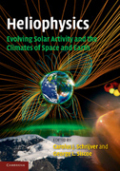
Heliophysics: evolving solar activity and the climates of space and earth
Schrijver, Carolus J.
Siscoe, George L.
The third of these texts focuses on the sunspot cycle and its effects on space weather and planetary climates. This final book in this series of three heliophysics texts, published in 2010, focuses on long-term variability from the Sun's sunspot cycle and considers the planetary system's evolution from a climatological perspective. With additional online teaching materials, it constitutes both a textbook and a foundational reference for researchers in the Earth and space sciences. This final book in this series of three heliophysics texts,published in 2010, focuses on long-term variability from the Sun's sunspot cycle and considers the planetary system's evolution from a climatological perspective. With additional online teaching materials, it constitutes both a textbook and a foundational reference for researchers in the Earth and space sciences. Heliophysics is a fast-developing scientific discipline that integrates studies of the Sun's variability, the surrounding heliosphere, and the environment and climate of planets. Over the past few centuries, our understanding of how the Sun drives space weather and climate on the Earth and other planets hasadvanced at an ever increasing rate. This 2010 volume, the last in this series of three heliophysics texts, focuses on long-term variability from the Sun'sdecade-long sunspot cycle and considers the evolution of the planetary systemover ten billion years from a climatological perspective. Topics covered range from the dynamo action of stars and planets to processes in the Earth's troposphere, ionosphere, and magnetosphere and their effects on planetary climate and habitability. Supplemented by online teaching materials, it can be used asa textbook for courses or as a foundational reference for researchers in fields from astrophysics and plasma physics to planetary and climate science. INDICE: Preface; 1. Interconnectedness in heliophysics Carolus J. Schrijver and George L. Siscoe; 2. Long-term evolution of magnetic activity of Sun-like stars Carolus J. Schrijver; 3. Formation and early evolution of stars and proto-planetary disks Lee W. Hartmann; 4. Planetary habitability on astronomicaltime scales Donald E. Brownlee; 5. Solar internal flows and dynamo action Mark S. Miesch; 6. Modeling solar and stellar dynamos Paul Charbonneau; 7. Planetary fields and dynamos Ulrich R. Christensen; 8. The structure and evolution of the 3D solar wind John T. Gosling; 9. The heliosphere and cosmic rays J. Randy Jokipii; 10. Solar spectral irradiance: measurements and models Judith L. Lean and Thomas N. Woods; 11. Astrophysical influences on planetary climate systems Juerg Beer; 12. Evaluating the drivers of Earth's climate system Thomas J. Crowley; 13. Ionospheres of the terrestrial planets Stanley C. Solomon; 14. Long-term evolution of the geospace climate Jan J. Sojka; 15. Waves and transport processes in atmospheres and oceans Richard L. Walterscheid; 16. Solar variability, climate, and atmospheric photochemistry Guy P. Brasseur, Daniel Marsch and Hauke Schmidt; Appendix I. Authors and editors; List of illustrations; List of tables; Bibliography; Index.
- ISBN: 978-0-521-13020-2
- Editorial: Cambridge University
- Encuadernacion: Rústica
- Páginas: 526
- Fecha Publicación: 12/01/2012
- Nº Volúmenes: 1
- Idioma: Inglés
